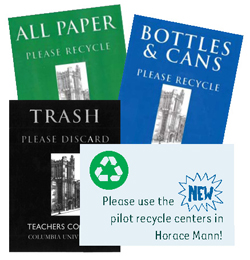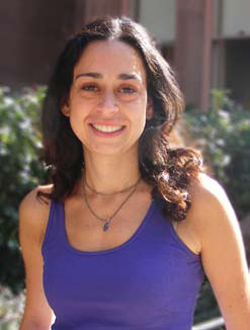Recycling Centers at TC
Horace Mann's new "green" look
Horace Mann’s new colors this season are blue, green and, black: the shades of new, brightly-hued and labeled recycle bins. The new bins were put in place by the Facilities Department and the Go Green Committee, which are working together to improve Teachers College’s recycling efforts. If the Teachers College community uses the bins, the Go Green Committee will install them in all College buildings.
Each recycle center in the hallways of the first four floors of Horace Mann has one blue recycle bin for paper, one green can for bottles and cans, and one black container for non- recyclables. Inside the classrooms, large trash bins have been replaced with smaller bins, which are for emergency use only (for example, if someone gets sick). While the new recycle centers are great for those who used to carry around empty plastic bottles in search of a recycle bin, others may not be familiar with the benefits of recycling or how and what to recycle.
Why should you recycle?
In the United States
Recycling protects our health and environment by removing harmful substances from the waste stream. Recycling also conserves our natural resources, cuts our use of landfills and incinerators in half, and saves money and energy. Energy savings from recycling aluminum cans in 1998 alone were enough to light a city the size of Pittsburgh
What should you recycle?
It is important to know, because of contamination resulting from the mixing of proper and improper materials, Teachers College could not recycle hundreds of pounds of recyclables last year. Thomas Daly, Facilities Manager, explains that “if there is a form of contamination, we do not go into the bags and separate the items—it gets put with the regular trash.” For example, if a bag of paper contains a dirty napkin, the entire bag of recyclable paper will be thrown out with the regular trash. Plenty of the blame for contamination lies with confusion over what can and cannot be recycled.
The blue “paper” bins, are for all white, colored and glossy paper (staples are OK), envelopes (windows OK), smooth cardboard (such as, cereal boxes), paper bags, newspapers, magazines, soft-cover books, and corrugated cardboard.
The green “bottles and cans” bins are for milk and juice cartons, glass bottles and jars, plastic bottles and jugs, metal cans, and clean aluminum foil wrap.
The black “trash” bins, are for napkins, paper towels, tissues, soiled paper plates or cups, plastic or wax-coated paper (such as, candy wrappers and take-out containers), hardcover books, books with spiral bindings, photo paper, plastic items other than plastic bottles and jugs (such as, yogurt containers, plastic toys, cups, bags), glass items other than bottles and jars (such as, glassware, light bulbs, and mirrors), and Styrofoam.
What happens when the recycle bins at TC are emptied?
“The trash is picked up daily and brought to a location where we separate the bags,” Daly says. “Dark bags are considered regular trash and clear bags are considered recycle trash. When the bags arrive sealed to the central location, we have staff separate the clear/black bags to their appropriate areas for the carting truck to pick-up.” That means even though you may not see it, Teachers College does, in fact, recycle. Remember, however, that if clear bags are contaminated, they are placed with the regular dark trash bags. So, please be extra careful not to contaminate recycle bins, and don’t be discouraged if you see a clear bag being thrown out with the dark trash bags.
Are the recycle centers working?
The new recycle centers are, for the most part, being used correctly. During the first week of implementation, members of the Go Green Committee monitored the new bins and calculated an 87.5 percent compliance rate. The biggest contamination culprits were paper coffee cups, plastic cups, and candy wrappers. However, members of the Teachers College community anticipate positive changes. Teraesa Vinson, full-time lecturer in the Clinical and Counseling Department says that it may take time for people “to get used to [the bins], so they may make some errors at first. But they are really beneficial—so thank you!”
If you think that you are only one person who can’t possibly make a difference, consider this: If every individual decides not to recycle, our landfills will get bigger, our water will get dirtier, and our natural resources will be eliminated. Also, think of the future generations who will have to deal with our current waste. So, please recycle and make your contribution in the Horace Mann recycle Centers. And, as always, keep it green.
For more information about recycling, the Go Green Committee, to inquire about a tour of the area where trash is separated, and/or to share comments, please contact me at gogreentc@gmail.com.
Published Tuesday, Nov. 24, 2009

